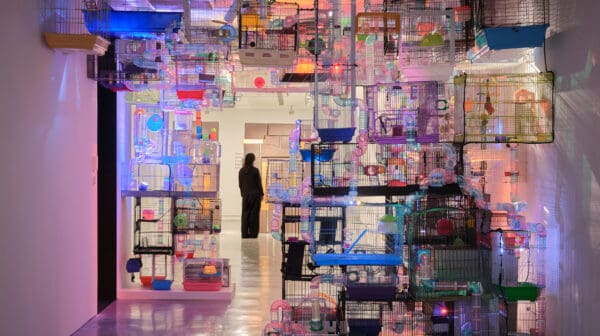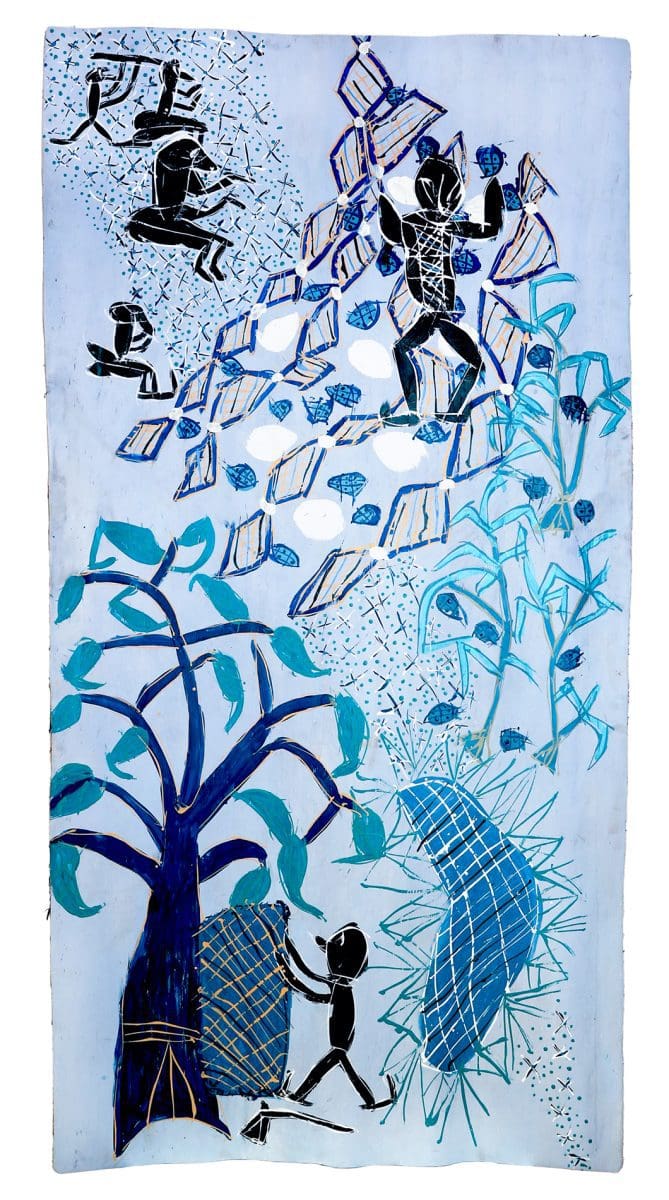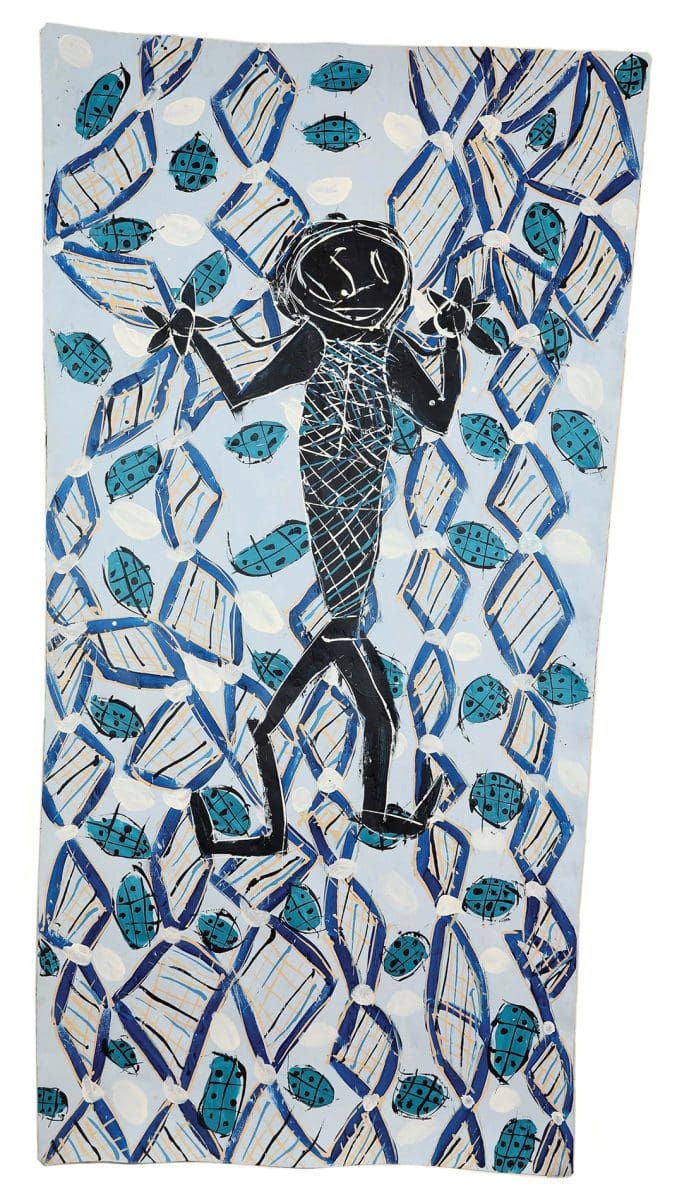
Material curiosities: Primavera 2025
In its 34th year, Primavera—the Museum of Contemporary Art Australia’s annual survey of Australian artists 35 and under—might be about to age out of itself, but with age it seems, comes wisdom and perspective.
While Djapu artist Dhambit Munuŋgurr seemed to burst onto the scene with her tremendous installation of vibrant blue bark paintings and larrakitj (hollow logs) for the National Gallery of Victoria Triennial in 2020, she had in fact been painting for over 40 years, since the age of 12.
Munuŋgurr comes from an extraordinarily creative lineage; one where art, politics and Yolŋu lore coexist. Her artist grandfather Muŋgurrawuy Yunupiŋu (c.1904-1979) was a contributor to the 1963 Yirrkala Church Panels—the first significant claim to land by Indigenous Australians through the documentation of ancestral narratives. And her artist parents Mutitjpuy Munuŋgurr (1932-1993) and Gulumbu Yunupiŋu (1945-2012) were both first prize winners at the National Aboriginal and Torres Strait Islander Art Award (NATSIAA). Munuŋgurr’s uncle Dr M. Yunupiŋu AM (1956-2013) was the lead singer of Yothu Yindi, and her son Gapanbulu Yunupingu plays yidaki in the group and sometimes fronts the band.
Art has always been a part of Munuŋgurr’s life—as she says in an interview for The Guardian, “It keeps me alive.” Yet even with this creative background, it is remarkable that in just a few short years her unique and singular visual language has seen her become one of this country’s most celebrated artists. Munuŋgurr, who works in the north-east Arnhem Land community of Yirrkala, is now rightly part of a cohort of Yolŋu painters who are together transforming our understanding of what it means to be a contemporary artist in Australia today.

Munuŋgurr’s journey as an artist is one of determination and resilience, and is now well told, but bears repeating, nonetheless. After being hit by a car in 2007, Munuŋgurr suffered life-threatening injuries, which have seen her confined to a wheelchair with restrictions to both her movement and speech. Painting became central to her recovery. To this end, Munuŋgurr was given special permission from the community to deviate from the Yolŋu custom of only painting with natural ochres collected from Country (such as gapan [gypsum], ochre and sand) and to instead use store-bought acrylic paint, which saved her from having to grind pigments by hand.
Painting with her non-preferred hand with a marwat (human hairbrush), Munuŋgurr initially echoed the traditional Yolŋu palette by working in orange, red, yellow and black acrylics. However, over time, she also began to include non-earth colours (such as green, for trees) in her work. She came upon blue around 2019, choosing it “because the earth is blue, the sky is blue and the sea is blue”, and has settled on a dazzling array of blues for her paintings since that time.
Munuŋgurr is not afraid to enter into the arena of contemporary Australian politics in her work. Paintings from her last solo exhibition, such as Order and Welcoming the Refugees / Scott Morrison and the Treasurer, both 2021, included contemporary Yolŋu participants in important political events, emphasising the fact that these events and the perspectives they bring to bear, affect and implicate all Australians, including Yolŋu people.
In the commanding bark diptych Welcoming the Refugees / Scott Morrison and the Treasurer, Munuŋgurr depicts groups of Yolŋu men and women pushing the former prime minister and former treasurer out to sea in her own version of ‘turning back the boats’. In the left-hand panel of the work the Yolŋu are welcoming the refugees to their shores; whereas in the right, Dhambit’s lively brushstrokes make the Yolŋu figures jostle and move in a combined show of determination and force, as the former prime minister and former treasurer are evicted from our shores and delivered into the threatening jaws of a large shark.

Given the artist’s previous paintings of Macassan fisherman, and the long history of cross-cultural trade that has enriched the Top End for centuries, the work takes on a particular significance, overturning colonial notions of ‘discovery’ and of the cultural isolation of Indigenous Australians in ‘remote’ communities.
In another astute take on contemporary politics, Order depicts former prime minister Julia Gillard’s misogyny speech—an iconic moment in Australian politics that is now known around the world. Munuŋgurr portrays Gillard standing in parliament surrounded by seated politicians, with a group of Yolŋu in the bottom left of the composition storming the House, their spears held aloft while dancing the songline of “Bol’ŋu” or “thunderman”, which is an embodiment of the wet season.
As the new works for her forthcoming exhibition at Roslyn Oxley9 Gallery demonstrate, Munuŋgurr’s art continues to be a powerful force of self-expression and biography, and a generous source of learning about Yolŋu culture and beliefs. Named after Archie Roach’s 1990 debut single Took the Children Away (which was her mother’s favourite song), Munuŋgurr’s painting of the same title shows the authorities—in their cars and boats—forcibly removing the children to the Methodist Mission on Croker Island, which was established in 1941 and, shamefully, not closed until 1968. In a characteristically imaginative mix of real-life history and popular culture, Munuŋgurr includes the girls from Rabbit Proof Fence hiding under the trees, along with mothers from the community crying for their stolen children.
Before 1970, no Yolŋu women painted sacred themes on bark or larrakitj in their own right. If we reflect upon the relatively short journey from there to today—and to a world where Munuŋgurr’s iridescent blue works combine ancient lore and 21st century politics—we are reminded, yet again, that Indigenous art is contemporary art, and that the works coming out of the Buku-Larrnggay Mulka Art Centre are some of the most rich and vital forces in artmaking in Australia today.
Dhambit Munuŋgurr
Roslyn Oxley9 Gallery
1—23 July
This article was originally published in the July/August 2022 print edition of Art Guide Australia.